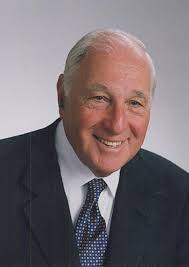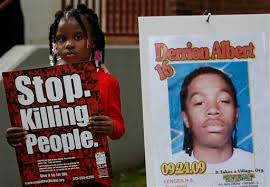 |  |
The brutal murder of Derrion Albert, a 16-year-old honor student at Chicago’s Fenger High School, has focused national attention on the savage gang warfare that enveloped the school in an atmosphere of fear and despair.
Recorded on an amateur’s cell phone video camera and seen nationally on the Internet, the murder was just another one of the 24 deadly student shootings in Chicago in 2006-2007, 23 in 2007-2008 and 34 deaths last year. More than 40 children under 18 have been murdered in Chicago so far this year.
But this murder, seen nationally, immediately brought Jesse Jackson Sr. to the school to demand more job opportunities for the community (although two of the four arrested assailants had jobs) and Louis Farrakhan there to invoke God. U.S. Attorney General Eric Holder appeared, stating that, “This is a wake-up call,” and Education Secretary Arne Duncan said that an emergency grant of $500,000 would go to Fenger High School for counselors and other programs. Mayor Richard Daley pledged more police officers at the school and announced plans to use one million dollars from Chicago’s parking meters for an after school jobs program. Fenger’s principal initially declined comment, but in her first public statement expressed her sympathy for Albert’s family.
The normally vocal teachers union representatives were not heard from because Fenger’s teachers are well-paid ($59,950 average), the school’s class sizes (13 students per class) are at recommended levels, and Fenger’s annual per capita expenditures ($13,200 per student) are above Illinois and national averages.
No one noted the absence of students’ fathers in the many interviews or news reports, and no one commented on Fenger’s documented 11th grade proficiency statistics, which show only 4% of Fenger students at grade level in mathematics and 9% in reading. Since it wasn’t on television, no one noticed that at nearby Paul Robeson High School, one out of eight girls was either pregnant or had children.
Chicago’s tragic experience highlights the fact that America’s education establishment continues to misread the problem it faces. Teaching is what someone does at a blackboard, learning is what takes place in the head of a student. And before that student can learn, motivation and other complex psychological factors must come into play.
The “cool” attitude cultivated in the inner city, with its exaggerated and misplaced sense of pride in manliness (demonstrated by impregnating girls, by self-destructive violence towards those supposedly showing “disrespect,” by flaunting contempt for all authority and by dismissing all “square” standards)—is a part of the problem we refuse to recognize.
The counter-culture value system reflected in gangsta rap lyrics of songs like Ice Cube’s “Hood Mentality” or Nas’ “Shoot ‘Em Up” work against the teacher, and the only way we know to fight it is by counter-influences early in life. This is not a new thought.
The effective role played by America’s Catholic parochial schools in transforming the largely dysfunctional peasantry fleeing Ireland’s 19th century potato famine into middle class Americans is well-documented. New York’s Archbishop John Hughes, who founded a network of some 100 Catholic schools, brilliantly stressed teaching not only the “three R’s” but also a code of personal conduct that non-parochial school students received from moralizing textbooks like McGuffey’s Readers or the works of Benjamin Franklin and Horatio Alger.
Individual responsibility, self discipline, integrity, hard work, thrift and deferred gratification were imprinted on young minds, along with politeness and cleanliness. (Daniel Patrick Moynihan liked to point out that in his parochial school days, even chewing gum or whispering in class excited the wrath of God!)
19th Century Jewish immigrants and 20th century Asian immigrants came from traditions valuing education, strong families and personal achievement that were counterparts to what Max Weber called the “Protestant Ethic.”
When White House Press Secretary Robert Gibbs commented on events at Fenger saying, “The government cannot regulate what’s in people’s hearts,” someone might have pointed out that 93 years ago, Sigmund Freud wrote, “The little human being is frequently a finished product in his fourth or fifth year and only gradually reveals in later years what lies buried in him.”
More recently, the work of Nobel Laureate Gary Becker on human capital and of Nobel Laureate James Heckman on education have confirmed what Freud—and recent experience—indicated clearly.
Carefully documented, thorough studies of “control groups” repeatedly demonstrate that children from chaotic or abusive backgrounds thrive when exposed to high quality pre-school education.
We know that the five-year-old who learns to wait patiently for his or her turn, who learns to share toys, who learns to appreciate justified praise, who learns to ask questions and to express ideas and opinions, who learns that “cause” leads to “effect”—such a child will not turn into the typical Fenger student described by the teachers as “constantly fighting, discussing little besides drugs, sex and violence, with a grim outlook on life, little thought of the future and with no motivation to achieve.”
Yes, the endless cycle of dysfunctional parents producing dysfunctional children can be halted, by exposing impressionable pre-schoolers to attitudes, values, outlooks and practices that prepare them to function effectively in the modern world.
Today’s “Chicago” approach—more police at school, safer buses though “war zones,” job training programs, counseling—will not produce the hoped for results: higher secondary and college graduation rates with less remediation; fewer teen pregnancies; less violent crime and imprisonment; increased incomes with higher taxes paid; more productive and fulfilling lives. However, high quality pre-schooling will produce these results—not immediately, but in the foreseeable future.
“Necessary but not sufficient” is how physicists describe the relationship of oxygen to a fire; and high quality preschooling relates similarly to a child’s future development. Of course, positive home influence, and proper elementary and high school exposure play their roles; but earliest formative experiences are crucial.
Many pre-school measures proposed today are well-intentioned but ineffective. They try to do on the cheap what really should be a labor-intensive experience conducted by well-prepared teachers.
The earliest Head Start programs—and some today—were more concerned with jobs for service providers than results for service recipients. The really effective ones, such as the Perry Preschool Program, whose impressive results have been studied for years, have highest standards but equally higher costs.
High quality pre-schooling is expensive, but worth it. It means college-educated pre-school teachers with extensive vocabularies and a proper command of the language, with post graduate training in child psychology and early education. It means that pre-school teachers must receive the same salaries and benefits as elementary school teachers and have similar career prospects. It means programs with parental involvement and parental training, because merely giving birth to a baby no more prepares one to be a mother than buying an automobile prepares one to drive it.
A properly prepared parent will preclude a child from entering the first grade with self-confidence undermined, and with natural curiosity and inherent desire to learn dampened. A proper pre-school program will preclude the child who has never heard the language spoken correctly, who has never been read to or even seen books, who has never learned how to relate comfortably to others. High quality pre-school education will encourage a child to develop a sense of “right” and “wrong,” to take pride in the right and feel shame in the wrong. It will help a child to develop expectations that will guide behavior and a way of looking at the world for the rest of that child’s life. In addition to preparing children to read, write, count and think, quality programs stimulate a child’s self-control, curiosity, self-confidence and sense of the future.
The economic case for high quality preschooling is as compelling as the social case. In New York today, a high school dropout will cost the city over the lifetime of that child more than a million dollars in lost taxes, welfare payments, criminal justice expenses, health-related costs, etc. A New York State study shows a return of seven dollars for every dollar spent on high quality preschooling, and many studies, by the Brookings Institution and others, show a 10% to 16% internal rate of return. Nobel Laureate James Heckman demonstrates that preschooling is key to improving America’s international economic competitiveness.
Our problem today is not what to do but how to do it—how to finance the programs, how to train the teachers and, most importantly, how to convince the general public that our current expensive and fruitless spinning of educational wheels is not the answer to breaking the cycle of poverty, but that high quality pre-school education is the necessary prerequisite.
At the moment, our federal, state and municipal governments are broke. With New York City and New York State facing staggering deficits this year and next, the word is out that no new programs can be entertained and even existing expenditures must be pared.
Our role in such a climate is to press our case even more forcefully, even more effectively, so that when funds do become available, high quality pre-school education is at the top of the list.
Through meetings and statements, as individuals or through organizations, by Op-Ed pieces and conferences, by using any kind of public forum available and by personal contact with our legislators and educational administrators, we must convince the general public that high quality pre-school education gives “the biggest bang for the educational buck,” and then we must press for action.
This is a war we must win, and we haven’t even started to fight.
(Talks by Daniel Rose may be found on www.danielrose.org)
No comments:
Post a Comment